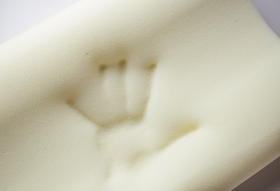
How is Memory Foam Made

First developed in 1966 by the NASA Research Centre, memory foam has been on an incredible journey since. It was originally created to improve the safety of aircraft cushions and was previously referred to as ‘slow back spring foam’ and ‘temper foam’. This likely explains why many consumers were first familiar with memory foam through the synonymous memory foam mattress that was created for the mass market by Tempur.
Memory foam was first available to the commercial market in 1991 and is termed as a viscoelastic material created by a specialist combination of chemical compounds. Also known as ‘low-resistance’ polyurethane foam, its construction is formed of foam cells that allow air to move between them, giving the product its slow elastic nature. Higher density memory foams react to body heat and in only a short amount of time the foam can mould to an accommodating shape. The chemical formulation is a well-kept and copyrighted industry secret, but memory foam manufacture follows a standard common process.
The initial component in the manufacture of memory foam is polyurethane plastic, which is then blended with two groups of petrochemicals referred to as monols and polyols. An exothermic reaction then commences, whereby the individual products combine to make a liquid. These chemicals aid the mixture’s flexibility and when combined with calcium carbonate, the optimum mixture thickness is developed. This chemical mixture is then gently warmed until the ingredients melt before it is then whipped together to incorporate air. The combination of air is important for development of the material’s springy nature.
Polyurethane is praised as being the main chemical component in memory foam and is largely responsible for the specialist chemical reactions that take place. This is because polyurethane is made from a group of polymer compounds that react with water, and, with an appropriate catalyst, then forms cell-like shapes that trap air. Manufacturers then use surfactants that are able to continue the reaction in a controlled manner, ensuring the ‘bubbles’ in the mixture develop to a regulatory size.

When the mixture is at the desired consistency it looks similar to a malleable soft dough. Most importantly, the mixture must be at the correct temperature in order to be correctly poured into its required mould. Due to the fragile chemical nature of the blend, it also needs to be dispensed into the mould at a specific rate to not disrupt the reaction that has taken place. If this is disrupted, the memory foam will not form in the desired material shape, springiness or make-up. Once in the mould, the air in the mixture is pumped out at a high pressure which forms the open cell structure of the foam. Once quickly dried and cooled, the foam slab stock is removed from the mould, washed, dried and checked for its quality. From here on, the foam block is then cut into smaller components, such as foam mattresses, which marks the end of the 8-hour long production process (on average).
The primary difference between the manufacture of polyurethane foam and memory foam is the unique selection of chemical compounds that are mixed together. The development differs via the addition of hydrocarbons to the chemical mixing process, though largely the method remains the same.
At eFoam, we pride ourselves on our specialist cut to size services and the bespoke nature of our products. Our extensive range of various foam types ensures that every customer is best matched to a product best suitable for their needs. Should you wish to speak with a friendly and knowledgeable advisor, please contact us.

